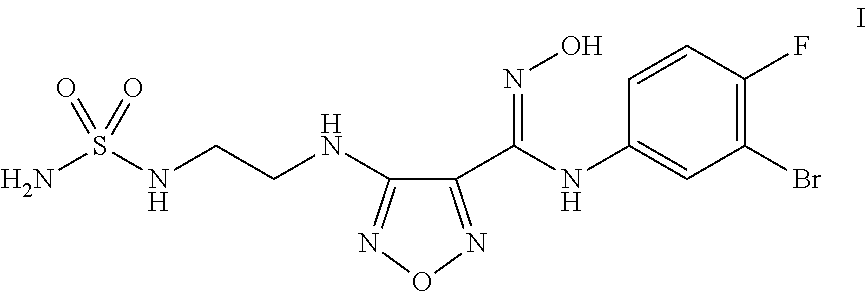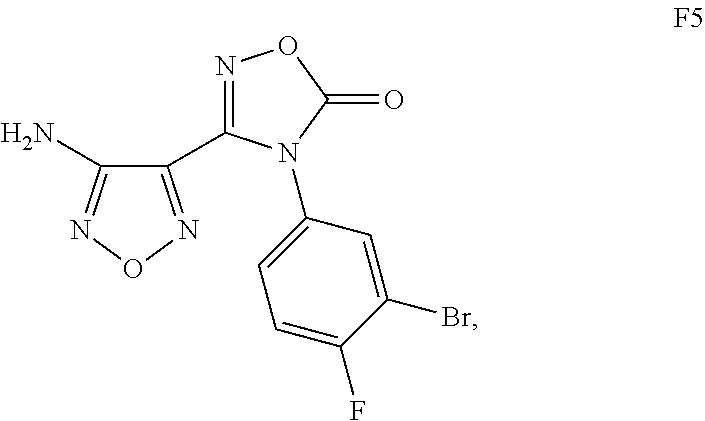Process for the synthesis of an indoleamine 2,3-dioxygenase inhibitor
a technology of indoleamine and dioxygenase, which is applied in the preparation of carbamic acid derivatives, drug compositions, organic chemistry, etc., can solve the problems of kynurenine metabolites such as quinolinic acid (quin), fetus cannot fully explain the survival of fetal allografts, and quinoline metabolites such as quinoline, which have toxic effects on brain function
- Summary
- Abstract
- Description
- Claims
- Application Information
AI Technical Summary
Benefits of technology
Problems solved by technology
Method used
Image
Examples
example 1
Synthesis of 4-({2-[(Aminosulfonyl)amino]ethyl}amino)-N-(3-bromo-4-fluorophenyl)-N′-hydroxy-1,2,5-oxadiazole-3-carboximidamide
[0270]
Step A: 4-Amino-N′-hydroxy-1,2,5-oxadiazole-3-carboximidamide (2)
[0271]
[0272]Malononitrile [Aldrich, product # M1407] (320.5 g, 5 mol) was added to water (7 L), preheated to 45° C. and stirred at 45° C. for 5 min. The resulting solution was cooled in an ice bath and sodium nitrite (380 g, 5.5 mol, 1.1 equiv.) was added. When the temperature reached 10° C., 6 N hydrochloric acid (55 mL) was added. A mild exothermic reaction ensued with the temperature reaching 16° C. After 15 min the cold bath was removed and the reaction mixture was stirred for 1.5 h at 16-18° C. The reaction mixture was cooled to 13° C. and 50% aqueous hydroxylamine hydrochloride (990 g, 15 mol, 3.0 equiv.) was added all at once. The temperature rose to 26° C. When the exothermic reaction subsided the cold bath was removed and stirring was continued for 1 h at 26-27° C., then it was sl...
example 2
Alternate preparation of N-[2-({4-[4-(3-Bromo-4-fluorophenyl)-5-oxo-4,5-dihydro-1,2,4-oxadiazol-3-yl]-1,2,5-oxadiazol-3-yl}amino)ethyl]sulfamide
[0292]
Step 1: Ethyl {[(tert-butoxycarbonyl)-amino]sulfonyl}aminoacetate (13)
[0293]
[0294]A solution of chlorosulfonylisocyanate (Sigma-Aldrich) (5.0 mL, 57.4 mmol) in dichloromethane (100 mL) was cooled to 0° C. Tert-butyl alcohol (4.26 g, 57.4 mmol, 1.0 equiv.) was added dichloromethane (100 mL) via an addition funnel. This solution was stirred at 0° C. for 30 min. Glycine ethyl ester hydrochloride (8.82 g, 63.2 mmol, 1.1 equiv.) was added followed by drop-wise addition of triethylamine (20.0 mL, 144 mmol, 2.5 equiv.) at 0° C. This reaction mixture was stirred at room temperature for 4 h. The reaction was diluted with dichloromethane (100 mL) and washed with 0.1 N hydrochloric acid and brine. The organic layer was dried over sodium sulfate and concentrated to give the desired product (13.2 g, 81.4%) as a crude off-white solid, which was used...
example 3
Alternate preparation of N-[2-({4-[4-(3-Bromo-4-fluorophenyl)-5-oxo-4,5-dihydro-1,2,4-oxadiazol-3-yl]-1,2,5-oxadiazol-3-yl)amino)ethyl]sulfamide
[0307]
Step 1a. tert-Butyl N-(2,2-dimethoxyethyl)sulfamoylcarbamate (17a)
[0308]
[0309]A solution of chlorosulfonylisocyanate (11.32 g, 80 mmol) in dichloromethane (120 mL) was cooled to 0° C. Tert-butyl alcohol (7.65 mL, 80.0 mmol, 1.0 equiv.) was added via addition funnel. The mixture was stirred at 0° C. for 1.5 h. To this mixture, a solution of aminoacetaldehyde dimethyl acetal (8.76 mL, 80.0 mmol, 1.0 equiv.) and triethylamine (TEA, 33.4 mL, 240 mmol, 3.0 equiv.) in methylene chloride (DCM 120.0 mL) was added drop-wise via addition funnel. The reaction was warmed to room temperature and stirred overnight. The reaction was treated with 0.1 N hydrochloric acid and the organic layer was washed with brine, dried over sodium sulfate and concentrated to give the desired product (15.6 g, 68.5%) as a crude off-white solid, which was used for the s...
PUM
| Property | Measurement | Unit |
|---|---|---|
| Acidity | aaaaa | aaaaa |
Abstract
Description
Claims
Application Information
 Login to View More
Login to View More - R&D
- Intellectual Property
- Life Sciences
- Materials
- Tech Scout
- Unparalleled Data Quality
- Higher Quality Content
- 60% Fewer Hallucinations
Browse by: Latest US Patents, China's latest patents, Technical Efficacy Thesaurus, Application Domain, Technology Topic, Popular Technical Reports.
© 2025 PatSnap. All rights reserved.Legal|Privacy policy|Modern Slavery Act Transparency Statement|Sitemap|About US| Contact US: help@patsnap.com



